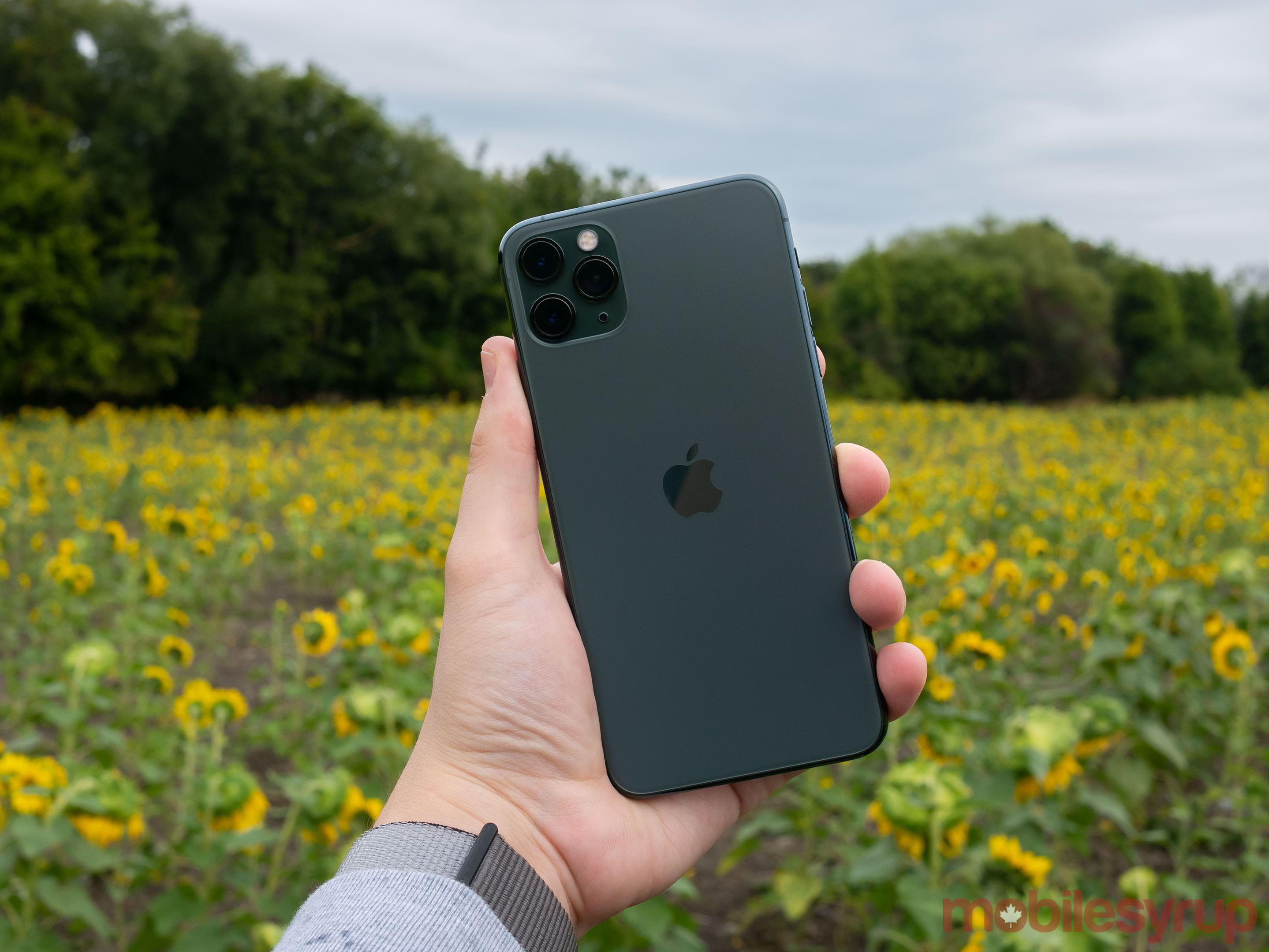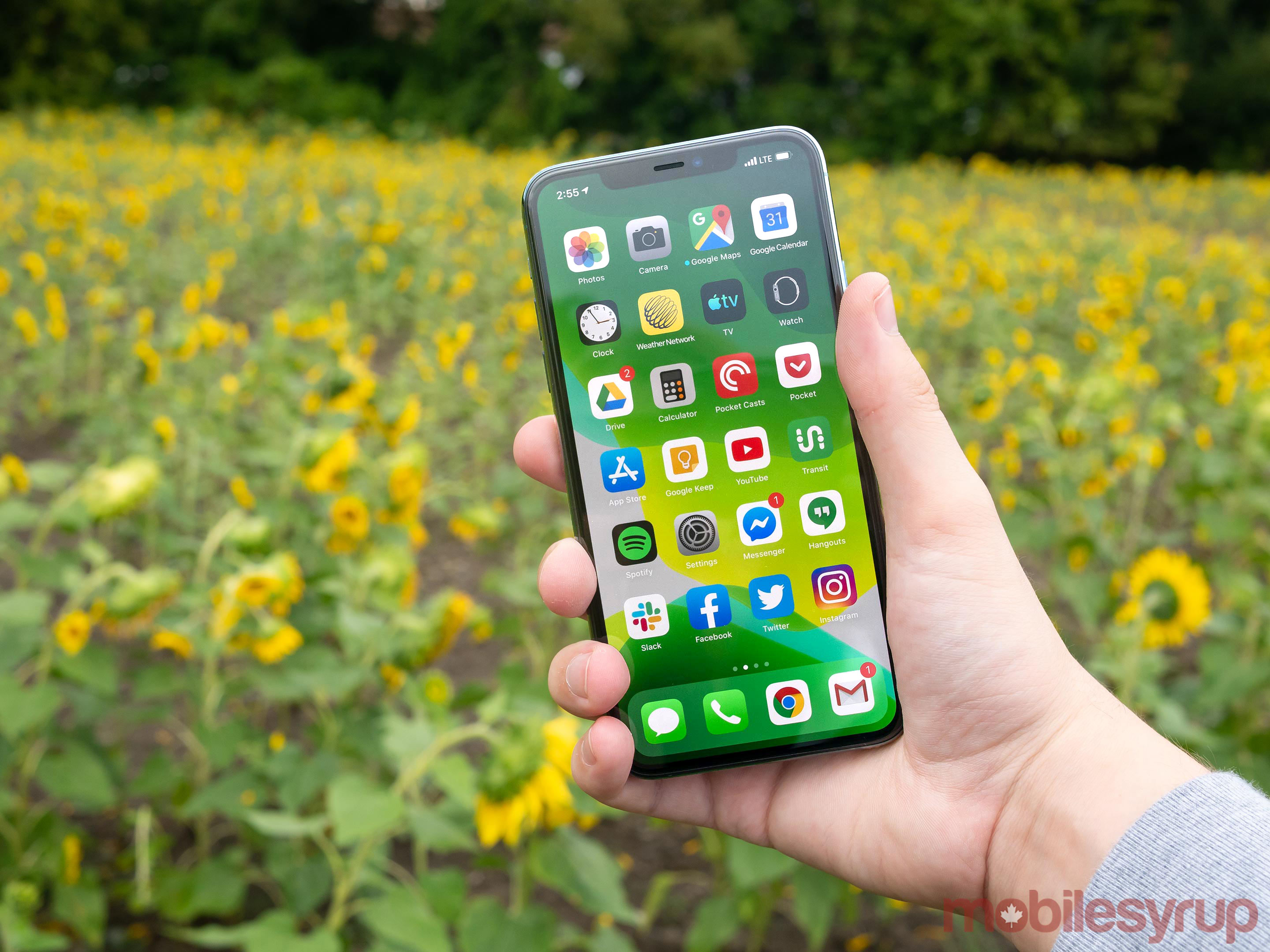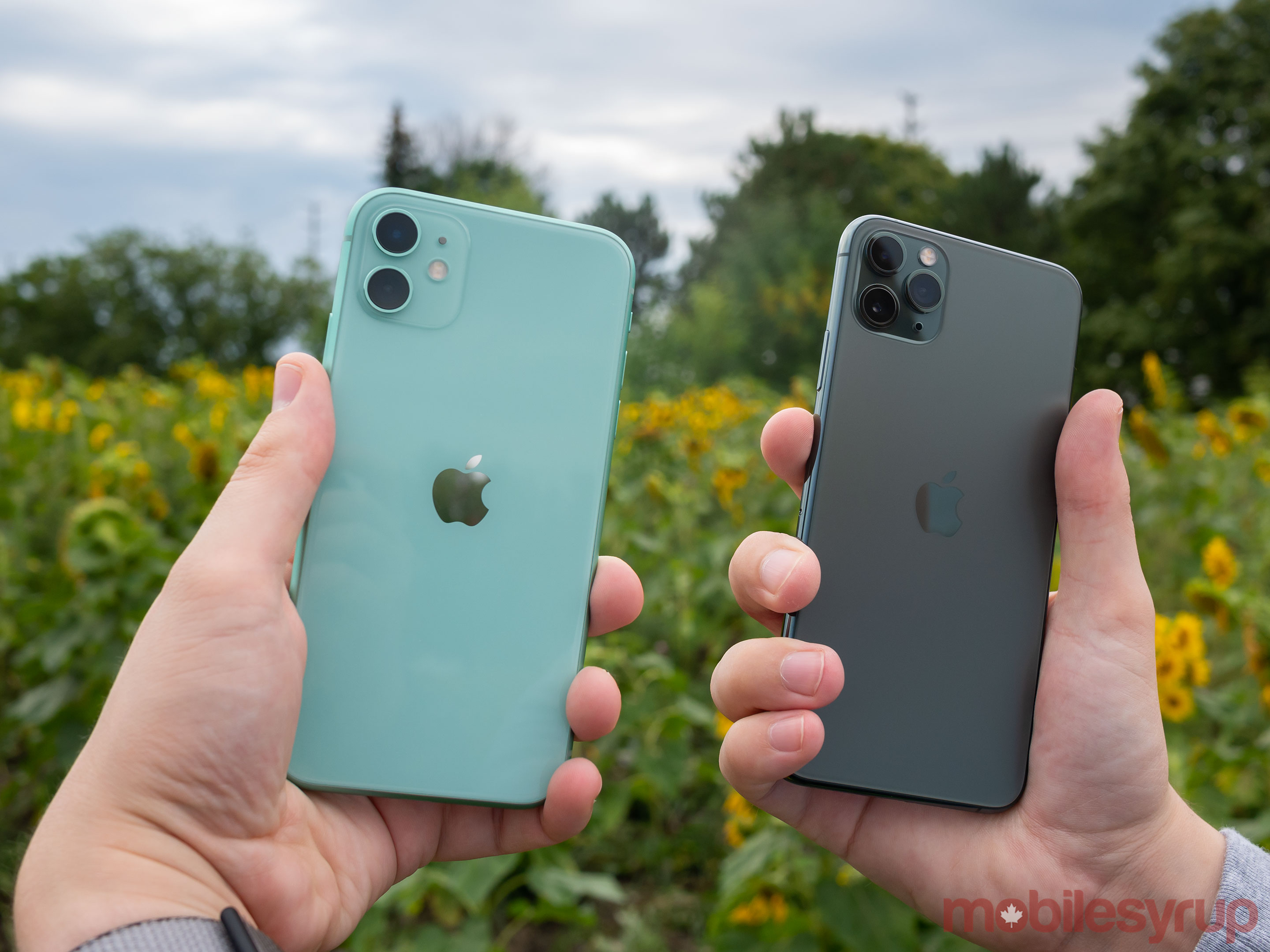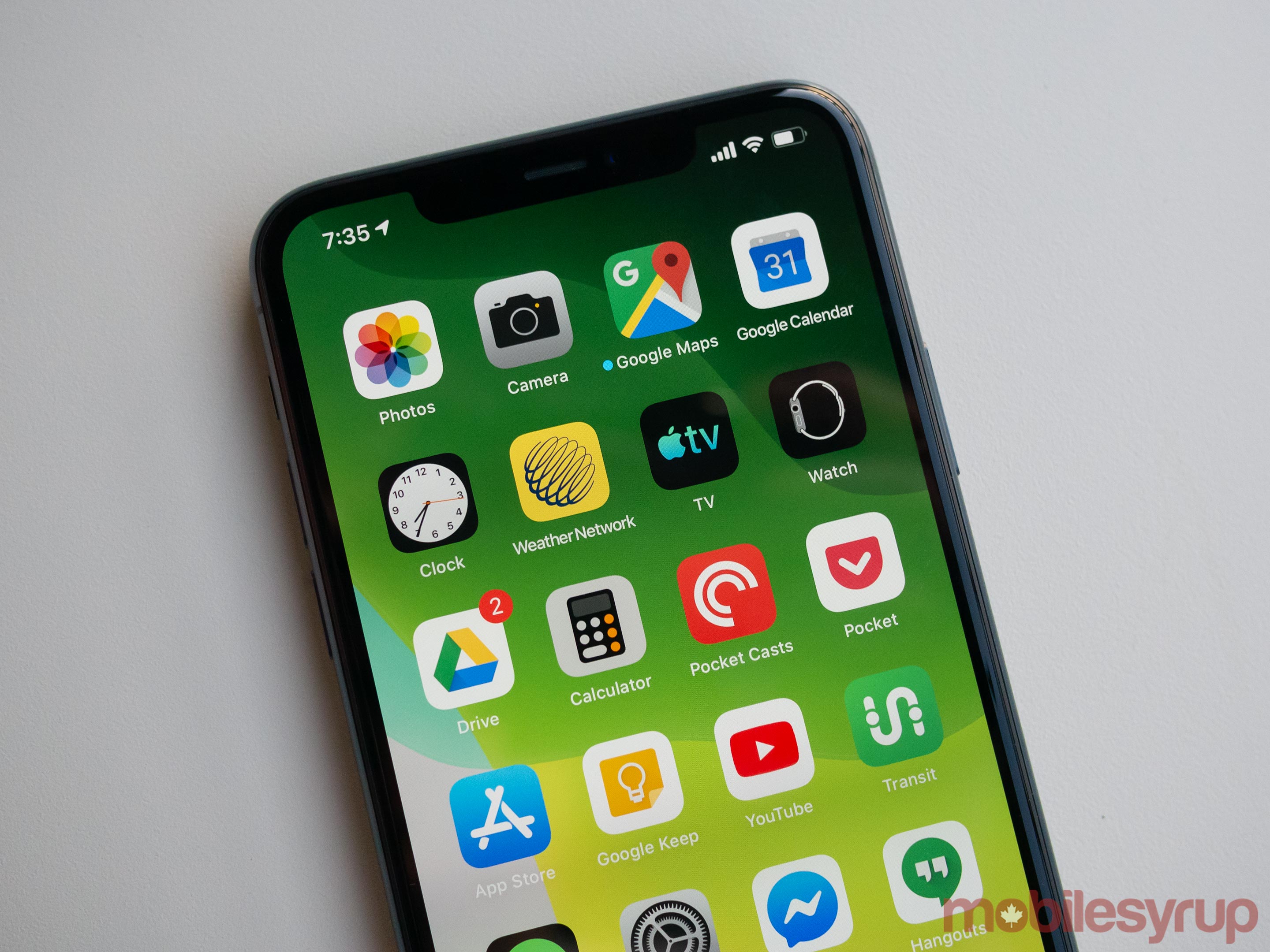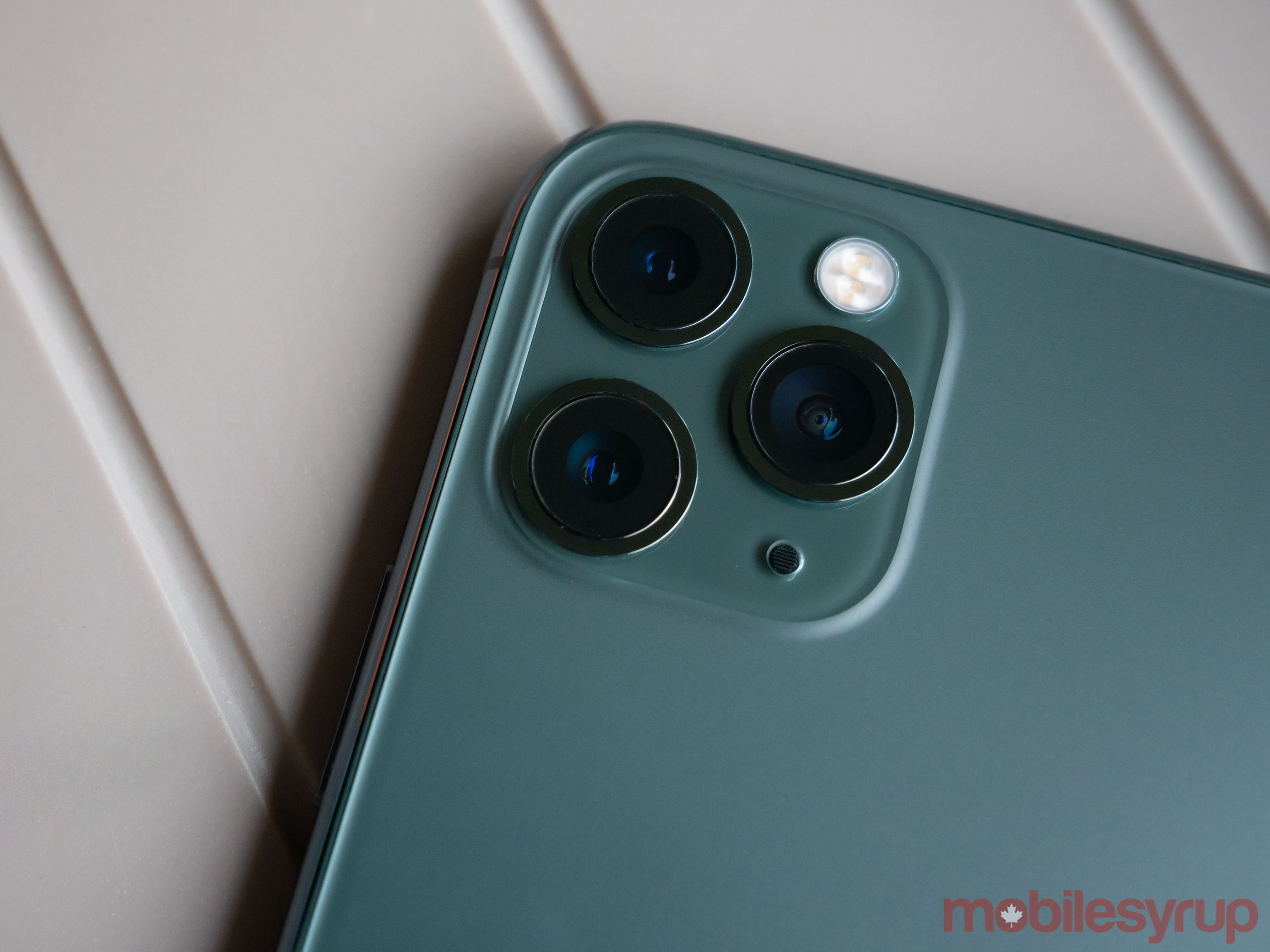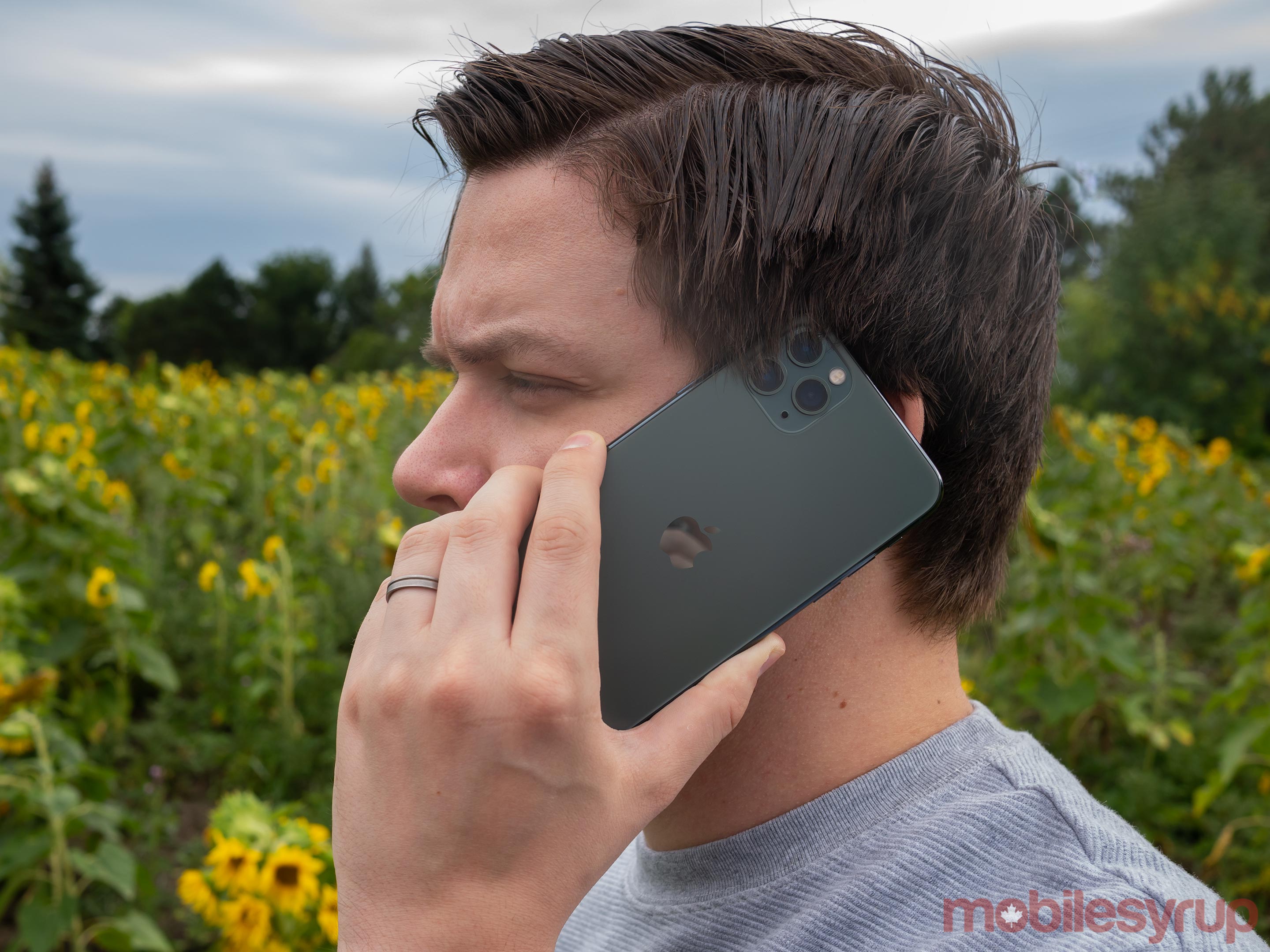
The Pros
- Vastly improved battery life
- 'Midnight Green' is stunning
- Third ultra wide-angle camera is great
The Cons
- Expensive
- Not a significant upgrade over the iPhone XS
- Reverse wireless charging for AirPods would have been nice
The iPhone 11 Pro and iPhone 11 Pro Max are set to go down as Apple’s most controversial smartphones of the last few years for one reason — the devices’ new three-camera array.
While the new Splinter Cell night vision goggles-like rear shooter array does indeed look offputting at first, it’s grown on me over the last few days. I’d even go so far as to say that I like it (more on this later).
Despite being Apple’s first numbered iPhone release since the iPhone X, there isn’t quite as much new about the device as many expected. That’s not to say that there aren’t new, notable features included in the iPhone 11 and iPhone 11 Pro, however.
Beyond the triple-camera system, there’s a new matte glass back, a bright ‘Super Retina XDR display,’ vastly improved battery life, better Face ID and, as always, a faster A13 Bionic chip that blows Qualcomm’s current processors out of the water. The bigger story this year, in some ways, is the features Apple decided not to upgrade or include in the iPhone 11 Pro.
As always, whether or not the iPhone 11 Pro or 11 Pro Max are for you will be determined by your interest in iOS as well as which iPhone you’re currently using.
This review primarily focuses on the iPhone 11 Pro Max. While I did use an iPhone 11 Pro, it was only for a brief period. The experience both smartphones offer is identical with display size being the only major difference.
iPhone 11 Pro
iPhone 11 Pro Max
Display
5.8-inch, Super Retina XDR, OLED True Tone display, 2436 x 1125 pixels, HDR 10, Dolby Vision
6.5-inch, Super Retina XDR, OLED True Tone display, 2688 x 1242 pixels, HDR 10, Dolby Vision
Processor
A13 Bionic
A13 Bionic
RAM
4GB
4GB
Storage
64GB, 256GB, 512GB
64GB, 256GB, 512GB
Dimensions (in.)
144 x 71.4 x 8.1mm
158 x 77.8 x 8.1mm
Weight
188g
226g
Rear Facing Camera
12-megapixel (f/1.8, OIS, wide angle) + 12-megapixel (f/2.0, OIS, telephoto) + 12-megapixel (f/2.4, OIS, ultra-wide angle) quad-LED 'True Tone' flash
12-megapixel (f/1.8, OIS, wide angle) + 12-megapixel (f/2.0, OIS, telephoto) + 12-megapixel (f/2.4, OIS, ultra-wide angle) quad-LED 'True Tone' flash
Front Facing Camera
12-megapixel (f/2.2)
12-megapixel (f/2.2)
OS
iOS 13
iOS 13
Battery
3190mAh
3969mAh
Network Connectivity
GSM/HSPA/LTE
GSM/HSPA/LTE
Sensors
TrueDepth Camera Sensor, Face ID, accelerometer, gyro, proximity, compass, barometer
TrueDepth Camera Sensor, Face ID, accelerometer, gyro, proximity, compass, barometer
SIM Type
Nano SIM, eSIM
Nano SIM, eSIM
Launch Date
September 20, 2019
September 20, 2019
Misc
Colours: Midnight Green, Gold, Silver, Space Grey, | Glass front and back, IP68 water/dust resistant
Colours: Midnight Green, Gold, Silver, Space Grey, | Glass front and back, IP68 water/dust resistant, Fast Charger 18W
Display
iPhone 11 Pro
5.8-inch, Super Retina XDR, OLED True Tone display, 2436 x 1125 pixels, HDR 10, Dolby Vision
iPhone 11 Pro Max
6.5-inch, Super Retina XDR, OLED True Tone display, 2688 x 1242 pixels, HDR 10, Dolby Vision
Processor
iPhone 11 Pro
A13 Bionic
iPhone 11 Pro Max
A13 Bionic
RAM
iPhone 11 Pro
4GB
iPhone 11 Pro Max
4GB
Storage
iPhone 11 Pro
64GB, 256GB, 512GB
iPhone 11 Pro Max
64GB, 256GB, 512GB
Dimensions (in.)
iPhone 11 Pro
144 x 71.4 x 8.1mm
iPhone 11 Pro Max
158 x 77.8 x 8.1mm
Weight
iPhone 11 Pro
188g
iPhone 11 Pro Max
226g
Rear Facing Camera
iPhone 11 Pro
12-megapixel (f/1.8, OIS, wide angle) + 12-megapixel (f/2.0, OIS, telephoto) + 12-megapixel (f/2.4, OIS, ultra-wide angle) quad-LED 'True Tone' flash
iPhone 11 Pro Max
12-megapixel (f/1.8, OIS, wide angle) + 12-megapixel (f/2.0, OIS, telephoto) + 12-megapixel (f/2.4, OIS, ultra-wide angle) quad-LED 'True Tone' flash
Front Facing Camera
iPhone 11 Pro
12-megapixel (f/2.2)
iPhone 11 Pro Max
12-megapixel (f/2.2)
OS
iPhone 11 Pro
iOS 13
iPhone 11 Pro Max
iOS 13
Battery
iPhone 11 Pro
3190mAh
iPhone 11 Pro Max
3969mAh
Network Connectivity
iPhone 11 Pro
GSM/HSPA/LTE
iPhone 11 Pro Max
GSM/HSPA/LTE
Sensors
iPhone 11 Pro
TrueDepth Camera Sensor, Face ID, accelerometer, gyro, proximity, compass, barometer
iPhone 11 Pro Max
TrueDepth Camera Sensor, Face ID, accelerometer, gyro, proximity, compass, barometer
SIM Type
iPhone 11 Pro
Nano SIM, eSIM
iPhone 11 Pro Max
Nano SIM, eSIM
Launch Date
iPhone 11 Pro
September 20, 2019
iPhone 11 Pro Max
September 20, 2019
Misc
iPhone 11 Pro
Colours: Midnight Green, Gold, Silver, Space Grey, | Glass front and back, IP68 water/dust resistant
iPhone 11 Pro Max
Colours: Midnight Green, Gold, Silver, Space Grey, | Glass front and back, IP68 water/dust resistant, Fast Charger 18W
It’s all about the ‘Midnight Green’
Getting near the hands-on area where Apple demoed its ‘Midnight Green’ iPhone 11 Pro Max was a battle. This makes sense because the iPhone Pro’s green colour is stunning, in part thanks to the smartphone’s new matte rear.
The iPhone Pro’s glass back now features a texturized matte look that makes the smartphone easier to grip and also prevents unsightly smudges and grease. While the rear is matte, it also has a frosted look to it. It’s a significant design shift and a look I haven’t seen many smartphones adopt over the last few years, with the Pixel 3 and Pixel 3 XL being the only exceptions — and even then, the back of Google’s flagship isn’t that matte.
Similar to last year, the iPhone 11 Pro and iPhone 11 Pro Max are also available in ‘Gold,’ ‘Silver’ and ‘Space Gray.’
The next change most will notice about the iPhone 11 Pro and iPhone 11 Pro Max is the new sizable camera bump. While I initially wasn’t fond of the rather large bump, which, along with the rear, is carved from one piece of glass, it’s grown on me considerably.
To be clear, I understand the complaints surrounding the bump because it does seem to be larger than it needs to be. With so many flagship smartphones looking similar to one another, the camera bump helps set the iPhone 11 Pro and iPhone 11 Pro Max apart from the competition. It also gives the iPhone 11 Pro some much-needed design flair.
Other than these changes, the iPhone 11 Pro and 11 Pro Max look identical to last year’s iPhone XS and iPhone XS Max, including the coloured stainless steel edges, the now-standard display notch and respective 5.8-inch and 6.5-inch display sizes.
If you weren’t a fan of the look of the iPhone XS and iPhone XS Max, that isn’t going to change this year.
It’s what’s inside that counts
As has become typical with the release of modern smartphones, it’s what Apple has changed inside the iPhone 11 Pro that’s the most interesting.
For example, the smartphones now feature Dolby Atmos simulated surround sound, similar to many Android flagships released in the last few years. Most probably won’t notice the shift in audio quality unless they’re watching a movie. Sound now fills the room better and seems to have slightly more direction to it.

Next, there’s the new ‘Super Retina XDR display’ that’s capable of up to 1200 nits of brightness. This makes the iPhone 11 Pro and iPhone 11 Pro Max’s display compatible with both HDR10 and the higher-end form of high-dynamic range, Dolby vision. The display is once again an OLED panel and features Apple’s ambient light-adjusting True Tone technology.
It’s important to note that Apple has ditched ‘3D Touch’ for the same ‘Haptic Touch’ functionality it featured in last year’s iPhone XR. This surprisingly took a little getting used to, especially when moving apps around on the Home Screen. Most iPhone users probably won’t notice a difference since 3D Touch wasn’t a prevalent feature to begin with. Apple also says that the new Super Retina XDR Display is 15 percent more efficient than the screen featured in the iPhone XS, resulting in improved battery life.
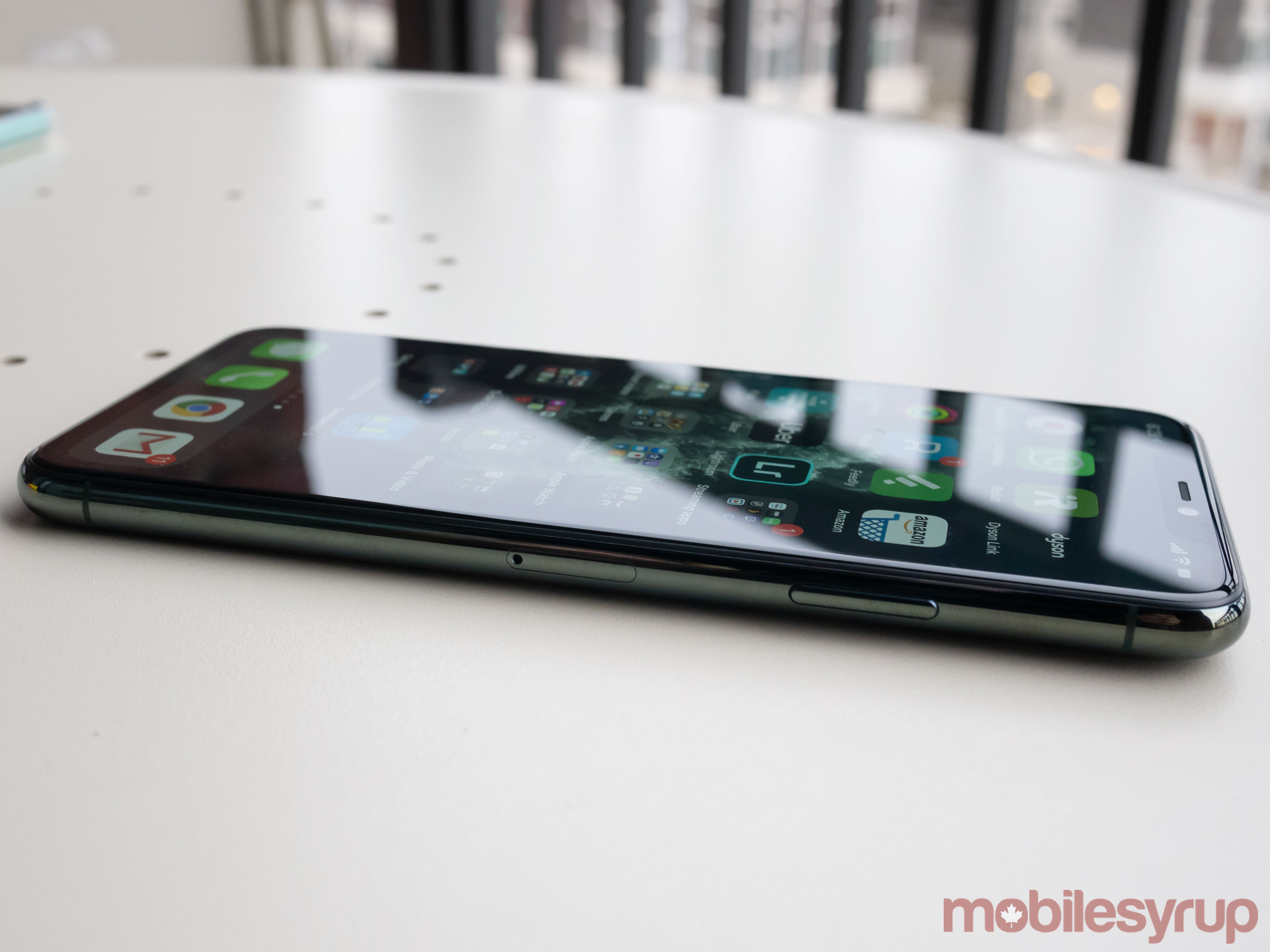
Overall, the iPhone 11 Pro and Pro Max’s screen looks stunning and once again sets an industry standard, with only Samsung’s Note 10+ and S10 coming close to challenging Apple’s display prowess. That said, the screen looks nearly identical to last year’s exceptional display, only with additional HDR compatibility and slightly increased brightness.
Apple has also added a new, more powerful A13 Bionic processor to its iPhone line this year. The A12 already packed a bigger punch than anything Qualcomm has released, and the A13 kicks this already sizable lead up a notch.
Apple says that the new A13 Bionic processor features two cores that are up to 20 percent faster and utilize 30 percent less power than the A12. The processor’s GPU is also 20 percent faster and uses 40 percent less energy, according to the tech giant’s calculations.
All this results in four hours more battery life with the iPhone 11 Pro and five hours of additional power with the iPhone 11 Pro Max. In my experience with the iPhone 11 Pro Max, Apple’s lofty claims seem accurate. My iPhone XS Max would frequently be nearly dead by 6pm, but with the new Pro Max, battery life barely hit below 55 percent at 7pm after a day of moderate use.
This extra battery life comes at a minor trade-off. The Pro Max weighs 226g and the Pro comes in at 188g. This is compared to 208g with the iPhone XS Max and 177g with the iPhone XS. Apple’s new iPhones are also a few millimetres thicker than their predecessors. While the difference is noticeable if you’re looking for it, I’d argue this is a worthwhile trade-off for roughly five additional hours of battery life. Hopefully, the trend of thicker smartphones that offer better battery life continues.
Speaking of battery life, Apple now includes a Lightning to USB-C cable in the box alongside an 18W USB-C charger, a long-overdue upgrade that charges the iPhone 11 Pro from zero to 50 percent in roughly 30 minutes.
Benchmark-wise, both smartphones achieve impressive results, with the iPhone 11 Pro Max’s multi-core score hitting ‘3509.’ You can find a screenshot below of the iPhone 11 Pro Max’s Geekbench scores.

Face ID has also been improved and is 30 percent faster. More importantly, it authenticates from additional angles, including when lying on your side. One of my most significant issues with Face ID in the past is that it never worked when lying in bed. Now, with the iPhone 11 Pro, that is thankfully no longer an issue.
As expected, the iPhone 11 Pro also still features Qi wireless charging, IP68 water and dust resistance up to 4-metres this year instead of last year’s 2-metre rating, Wi-Fi 6, Bluetooth 5 and faster Gigabit-class LTE (when a signal is available), along with support for 30 more LTE bands for roaming.
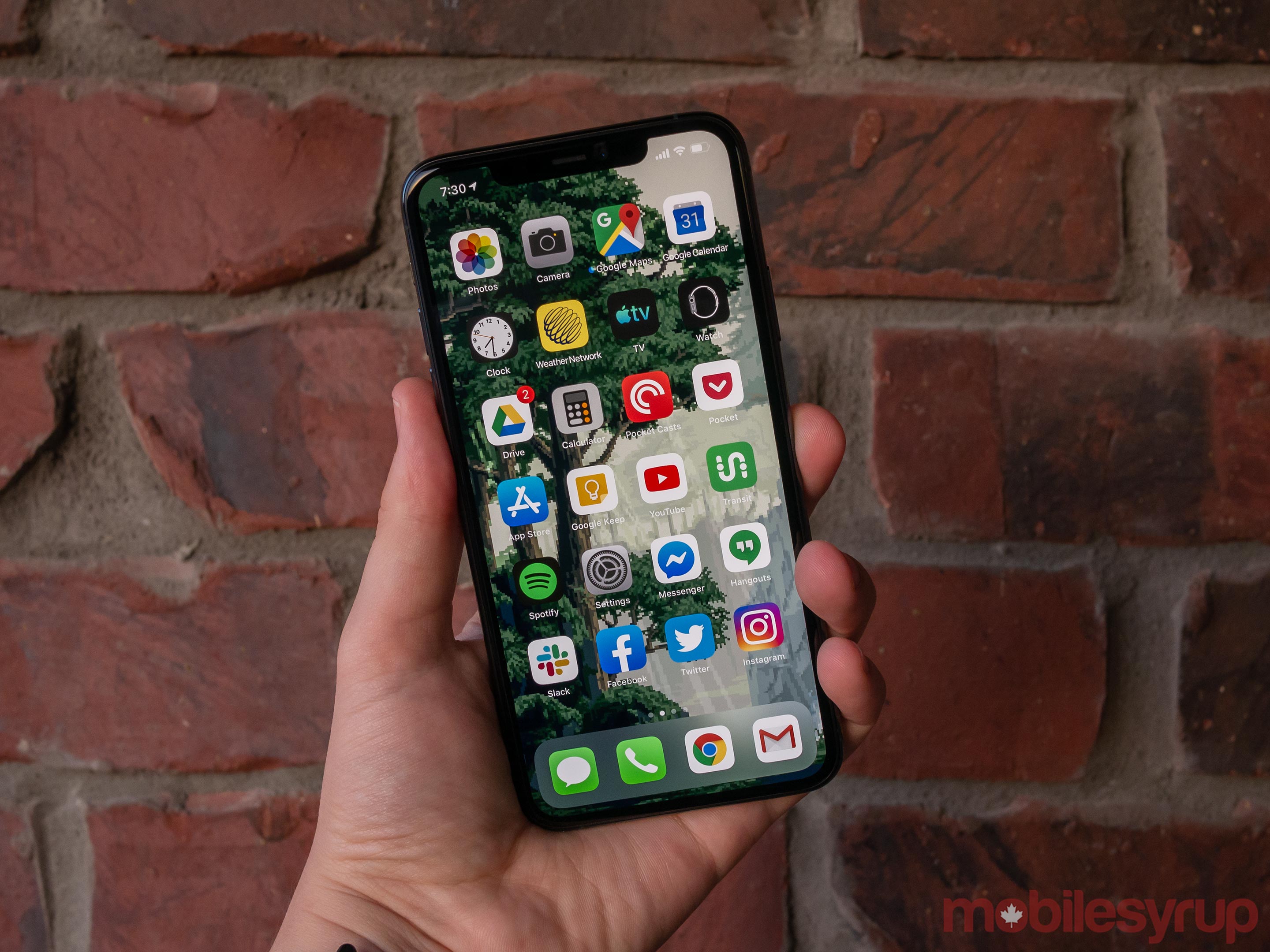
It’s important to note that the iPhone 11 Pro and iPhone 11 Pro Max feature a new Apple-designed U1 spatial awareness chip that helps the phone detect other nearby U1-enabled devices and improves AirDrop connectivity.
Apple says that this new chip will be enabled on September 30th. As it stands, its only use is to point your phone at AirDrop and U1-enabled devices you’d like to send files to, though it likely has something to do with Apple’s often-rumoured Tile-like Bluetooth tracking devices.
What’s also noteworthy about the iPhone 11 Pro series are the expected features Apple opted not to bring to this year’s smartphone, including the often-rumoured Qi reverse wireless charging and the iPad Pro (2018)’s 120Hz display technology. Hopefully, these are features Apple brings to its smartphone line next year.
Camera comeback
The iPhone 11 Pro and the iPhone 11 Pro Max are a blatant attempt on Apple’s part to reclaim the smartphone camera crown.
In most respects, that is precisely what the tech giant has accomplished with its new flagships.
First, there’s the new 12-megapixel, f/2.4 13mm ultra wide shooter that captures roughly four times the information in a picture when compared to the standard wide camera.
The ultra wide-angle is great for capturing landscape photos, architecture or large groups of people. Samsung and Huawei’s flagship devices have featured ultra wide-angle cameras for some time now, so it’s great to see Apple finally adding a more expansive shooter to the iPhone 11 Pro. Unfortunately, the ultra wide camera doesn’t feature optical image stabilization.
On the other hand, the 13mm wide camera, which comes in at 12-megapixels and f/1.8, features improved low-light performance and slightly faster autofocus.
Finally, the 52mm, 12-megapixel telephoto lens now features an aperture of f/2.0 compared to the iPhone XS’ f/2.4. This results in improved low-light performance with the telephoto shooter, especially when using ‘Portrait Mode.’ It’s also possible to get up to 4x optical zoom compared to last year’s 2x thanks to the addition of the new ultra wide camera. As someone who is often shooting landscape photos at a distance, I appreciated this feature.
Along with improvements to ‘Smart HDR’ that result in truer to life images, Apple has also added a new ‘Night Mode’ to the iPhone 11 Pro and iPhone 11 Pro Max. I spent a significant amount of time testing this feature. In general, Apple’s approach to night shooting seems very similar to the Pixel 3’s ‘Night Sight.’ It lightens the entire image, with particular attention paid to bright portions of the photo to prevent highlights from getting blown out.

The feature turns on automatically (you can also flip it off) and leaves the smartphone’s shutter open for a time usually ranging between one and three seconds. The iPhone 11 Pro then captures multiple images and fuses them. Generally, my experience with Night Mode was great, though various types of light sources in one image sometimes confused it.
In the photo comparison above, you can also see that the resulting image the iPhone 11 Pro Max creates is very similar to Google’s Night Sight with the Pixel 3 XL. Apart from the sky being slightly brighter, both images look very similar.
Then there’s ‘Deep Fusion,’ a new form of advanced HDR that stitches together nine photos courtesy of the iPhone 11’s neural engine. While Deep Fusion seems promising on paper, it isn’t set to launch until later this fall.
Other new camera features include Portrait Mode’s ‘High Key Mono’ that completely removes the background of an image and turns it black and white. It’s also now possible to alter portrait Mode’s Lightning intensity, giving you more control over what a photo looks like in post-production.
There are other changes to the camera experience as well. For example, Apple has revamped the iPhone’s stock camera app to allow users to capture outside of the app’s frame. ‘QuickTake’ also makes shooting video easier by just holding the shutter button.
On the video side of things, all three of the iPhone 11 Pro’s lenses support 4K video at 60fps with new stabilization that seems to match what Samsung’s Galaxy Note 10 and S10 are capable of.
And of course, there’s the horribly named 120fps slow-motion ‘Slofie’ shots. This is a fun, silly feature that matches functionality offered by several Android manufacturers. It’s also worth pointing out that you can take quick slow-motion videos of more than just people.
Beyond Slofies, the front-facing 12-megapixel TrueDepth camera can now snap wide-angle shots when rotated to landscape, which I actually found surprisingly useful. The HDR skin front-facing camera smoothing effect that was rampant with the iPhone XS and iPhone XS Max has also been turned down considerably, resulting in images that look more true to life.
The same can be said about the iPhone 11 Pro’s front-facing camera array, which processes images in a way that falls somewhere between the over the top look of Samsung’s photos and the more accurate images the Pixel 3 shoots. Photographs still look accurate and not over-processed, but colour also pops in a way that wasn’t present with the iPhone XS’s camera. Low-light performance has also been improved considerably across the board even when not using Night Mode.
I’ll have a more detailed camera comparison that pits the iPhone 11 Pro’s shooter against various Android devices up on MobileSyrup at some point in the next few weeks.
iOS 13
While the majority of iOS 13’s functionality is coming to all of Apple’s iPhones, it’s worth mentioning a few key features.
The new, revamped Photos app is great and easier to navigate, but the ability to edit both photos and video directly in the app is a welcome addition as well. Other notable iOS features include a system-wide dark mode that I hope more developers start adding to their apps, a revamped reminders app and more personalization with Messages that features the ability to share your real name and an image.
iOS 13 is by no means a massive update to Apple’s mobile operating system, but it does feature several useful subtle improvements.
There are new Animoji on the way as well, including a mouse, octopus and of course, a cow.
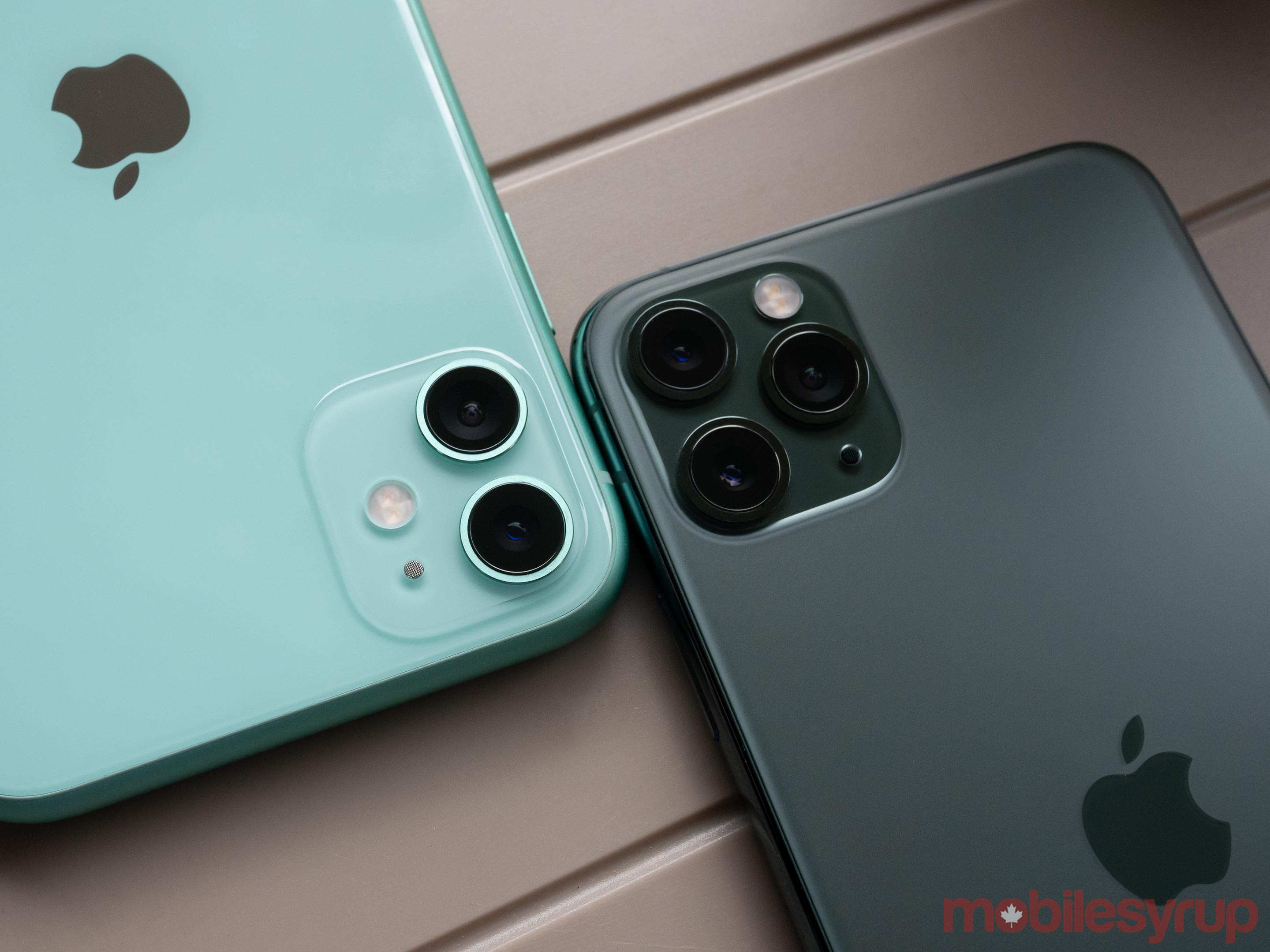
Meaningful iteration
As with nearly all of Apple's recent iPhones and even high-end Android devices, the iPhone 11 Pro and iPhone 11 Pro Max are an iterative step forward for Apple's smartphone line. If you were hoping for a full redesign or an abundance of new features, this isn't the iPhone you've been waiting for
While minor, many of the changes are actually meaningful, especially improvements to battery life, the third wide-angle shooter, much-needed performance improvements to the camera and the sizable performance boost provided by the new A13 Processor.
Whether or not the iPhone 11 Pro or 11 Pro Max is worth it for you will depend on what smartphone you're currently using, as well as how important iOS is to you. This decision is complicated by the fact that the iPhone 11, Apple's successor to the iPhone XR, is nearly as good as the Pro series, with its only notable missing feature being a telephoto lens and its LCD display.
With all that said, even with a few shortcomings, the iPhone 11 Pro and iPhone 11 Pro Max are set to go down as two of the best smartphones of the year.
The iPhone 11 Pro starts at $1,379 CAD for 64GB variant, $1,589 for the 256GB model and the 512GB variant costs $1,859. Meanwhile, the 6.5-inch iPhone 11 Pro Max starts at $1519 for the 64GB version. The 256GB costs $1,729 and lastly the $512GB is a whopping $1,999.
"Even with a few shortcomings, the iPhone 11 Pro and iPhone 11 Pro Max are set to go down as two of the best smartphones of the year"
MobileSyrup may earn a commission from purchases made via our links, which helps fund the journalism we provide free on our website. These links do not influence our editorial content. Support us here.


